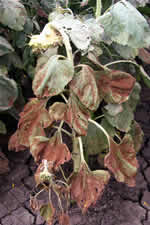Australia
January 25, 2007
The disease rust has always
been a serious issue for the sunflower industry, and researchers
now believe they may have found a way to beat it.
 |
|
For the minute reddish-brown rust
spores to show up so clearly there are millions
on these leaves. The spores become wind-borne
and spread the disease. |
|
The issue has been that rust
undergoes a sexual cycle to produce new strains that combine the
virulences of the parental strains. The new recombined strains
may then attack newly developed resistant varieties.
But Gary Kong from the
Queensland Department of Primary Industries and Fisheries
(DPI&F) says that a new management strategy might prolong the
useful life of resistant varieties.
"The situation with rust at the moment is similar to the one
doctors face with the common cold. They have to keep coming up
with new vaccinations as last year's is out of date.
"Our strategy is called gene-pyramiding and relies on an
analysis of strains of the rust pathogen collected over a
thirty-year period. This analysis attempts to predict which
strains the pathogen may or may not be able to recombine into a
new strain.
"Resistance genes that correspond to an unlikely strain
combination are identified and combined in a single hybrid.
"Combining resistance genes however, is not as simple as it
sounds and we've had to identify molecular markers for
resistance genes so that we can track the genes through the
successive generations required for hybrid development.
"Hybrids using pyramided genes are now being developed for
commercial use. These will have durable resistance to rust -
delaying the need to constantly renew varieties," Dr Kong said.
 The
research is being carried out by the DPI&F with support from the
Grains Research and Development
Corporation (GRDC) and in close collaboration with Pacific
Seeds. The
research is being carried out by the DPI&F with support from the
Grains Research and Development
Corporation (GRDC) and in close collaboration with Pacific
Seeds.
DPI&F will continue to monitor and collect different rust
strains to build on and refine understanding of how the rust
pathogen is evolving.
This vigilance is providing assistance to the industry in
itself, helping to ensure varieties are removed from commercial
sale as soon as their resistance breaks down.
"It's hard to tell how much rust costs growers, because
outbreaks are immediately detected and susceptible varieties
withdrawn.
"There is a significant cost to the seed companies in having to
regularly replace hybrids whose resistance has broken down.
"There is however no doubt, that without rust resistant
varieties, the sunflower industry would not be viable," Dr Kong
said.
"Once we develop varieties that stay resistant for longer - say
10-15 years rather than the current 3-5 years - it will cut the
costs involved in breeding programs.
"We should have the new durable varieties available for
commercial sale in around three years."
|
|